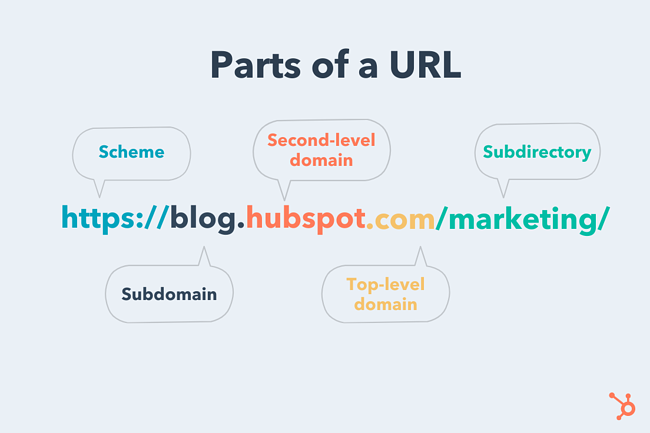If your website is like a house, then your website’s URL is like that house’s address. It defines where your website lives online, similar to how your home address determines where you live in a neighborhood, helping your visitors easily find your site. URLs also help Google understand what your website’s pages are about.
There are technically five elements of a URL, and they’re discreetly important for optimizing your site’s user experience (UX) and SEO. To help you develop a concrete understanding of every part of a URL, let’s explore each of them in detail.
Below is an illustration of the different parts of a URL.
 Let’s break down this URL structure below.
Let’s break down this URL structure below.
URL Structure
Scheme
 The scheme tells web servers which protocol to use when it accesses a page on your website.
The scheme tells web servers which protocol to use when it accesses a page on your website.
Nowadays, HTTPS — which stands for Hypertext Transfer Protocol Secure — is the most common scheme. It tells your web browser to encrypt any information you enter onto the page, like your passwords or credit card information, so cybercriminals can’t access it. This security protocol protects your website visitors and implementing it will help your site rank better on Google. That’s why implementing SSL is a must-do on any technical SEO guide.
Other schemes you might see are mailto://, which can open your computer’s default email service provider to help you draft an email to the email address you entered in the URL, and ftp://, which is a standard protocol for transferring computer files between a client and server on a computer network.
Subdomain
 If your website is like a house, your subdomains are like specific rooms in that house. A subdomain in a URL indicates which particular page of your website the web browser should serve up. For instance, subdomains like “blog” or “offers” will provide your website’s blog page or offers page.
If your website is like a house, your subdomains are like specific rooms in that house. A subdomain in a URL indicates which particular page of your website the web browser should serve up. For instance, subdomains like “blog” or “offers” will provide your website’s blog page or offers page.
Subdomains also bucket your website into its main content categories and shows Google and your visitors that there’s more information on your site than just a homepage.
Second-level Domain
 Your second-level domain (SLD) is the name of your website. It helps people know they’re visiting a certain brand’s site. For instance, people who visit “mlb.com” know they’re on Major League Baseball’s website, without needing any more information.
Your second-level domain (SLD) is the name of your website. It helps people know they’re visiting a certain brand’s site. For instance, people who visit “mlb.com” know they’re on Major League Baseball’s website, without needing any more information.
Top-level Domain
 The top-level domain (TLD) specifies what type of entity your organization registers as on the internet.
The top-level domain (TLD) specifies what type of entity your organization registers as on the internet.
For example, “.com” is intended for commercial entities in the United States, so a lot of American businesses register with a top-level domain of “.com”. Similarly “.edu” is intended for academic institutions in the United States, so a lot of American colleges and universities register with a top-level domain of “.edu”.
Subdirectory
 A subdirectory — also known as a subfolder — helps people as well as
A subdirectory — also known as a subfolder — helps people as well asweb crawlers understand which particular section of a webpage they’re on.
For instance, if you own an online store that sells t-shirts, hats, and mugs, one of your website’s URLs could look like “https://shop.yourstore.com/hats”. Notice that the subdomain is “shop” and the subdirectory is “hats.” That means this URL would serve up the “Hats” page, which is a subfolder of the “Shop” page. T-shirts and mugs would be other subfolders of this page.
URL Structure: Subtle Yet Essential
Even though URLs might seem simple and frivolous, they’re actually important for your website’s UX and SEO. And now that you understand the anatomy of a URL, check out the blog posts below to learn more about technical SEO.
![]()


